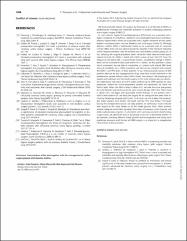| dc.contributor.author | Özyüksel, Arda | |
| dc.contributor.author | Ölmüşçelik, Oktay | |
| dc.contributor.author | Kayan, Ekin | |
| dc.contributor.author | Akçevin, Atıf | |
| dc.date.accessioned | 10.07.201910:49:13 | |
| dc.date.accessioned | 2019-07-10T19:56:29Z | |
| dc.date.available | 10.07.201910:49:13 | |
| dc.date.available | 2019-07-10T19:56:29Z | |
| dc.date.issued | 2013 | en_US |
| dc.identifier.citation | Özyüksel, A., Ölmüşçelik, O., Kayan, E. ve Akçevin, A. (2013). EComment. Interpretation of the data together with the management of cardiac surgery patients with diabetes mellitus. Interactive Cardiovascular And Thoracic Surgery, 270(11), 2901-2907. https://dx.doi.org/10.1093/icvts/ivt470 | en_US |
| dc.identifier.issn | 1569-9293 | |
| dc.identifier.issn | 1569-9285 | |
| dc.identifier.uri | https://dx.doi.org/10.1093/icvts/ivt470 | |
| dc.identifier.uri | https://hdl.handle.net/20.500.12511/2720 | |
| dc.description | WOS: 000327456100026 | en_US |
| dc.description | PubMed ID: 24243950 | en_US |
| dc.description.abstract | We have read with interest the analysis by Tennyson et al. of the role of HbA1c in predicting the mortality and morbidity outcomes in patients undergoing coronary artery bypass surgery (CABG) [1]. In such patients, higher fasting blood glucose (FPG) levels are associated with a higher incidence of arrhythmia, atelectasis and prolonged mechanical ventilation, whereas higher HbA1c levels are associated with a higher incidence of intra-aortic balloon counterpulsation, massive bleeding and multi-organ failure [2]. Although diabetes mellitus (DM) is traditionally known to be associated with an increased risk for CABG, there are also adverse outcomes reported in the literature indicating similar hospital mortality rates for diabetic and non-diabetic patient groups [3]. In fact, delaying the surgical procedure seems to be the safest measure when quadrupled mortality for CABG is noted with HbA1c values of over 8.6% [1]. Since the lifespan of red blood cells is around three months, any effective change in HbA1c levels will be assumed to take place within 10-12 weeks. So, the question is about which parameters we are able to manipulate in a patient with altered FBG levels who are candidates for a CABG procedure and how we can interpret and evaluate the HbA1c and FPG levels in these patients. In our clinical practice we put all DM patients who are on oral hypoglycaemic drugs onto dual insulin treatment in the preoperative period without taking HbA1c levels into account. | en_US |
| dc.language.iso | eng | en_US |
| dc.publisher | Oxford Univ Press | en_US |
| dc.rights | info:eu-repo/semantics/openAccess | en_US |
| dc.subject | EComment | en_US |
| dc.subject | Interpretation of the Data Together | en_US |
| dc.subject | Management of Cardiac | en_US |
| dc.subject | Surgery Patients | en_US |
| dc.subject | Diabetes Mellitus | en_US |
| dc.title | EComment. Interpretation of the data together with the management of cardiac surgery patients with diabetes mellitus | en_US |
| dc.type | letter | en_US |
| dc.relation.ispartof | Interactive Cardiovascular And Thoracic Surgery | en_US |
| dc.department | İstanbul Medipol Üniversitesi, Tıp Fakültesi, Cerrahi Tıp Bilimleri Bölümü, Kalp ve Damar Cerrahisi Ana Bilim Dalı | en_US |
| dc.department | İstanbul Medipol Üniversitesi, Tıp Fakültesi, Cerrahi Tıp Bilimleri Bölümü, Çocuk Cerrahisi Ana Bilim Dalı | en_US |
| dc.department | İstanbul Medipol Üniversitesi, Tıp Fakültesi, Dahili Tıp Bilimleri Bölümü, İç Hastalıkları Ana Bilim Dalı | en_US |
| dc.authorid | 0000-0002-9815-1848 | en_US |
| dc.authorid | 0000-0002-0799-4875 | en_US |
| dc.identifier.volume | 17 | en_US |
| dc.identifier.issue | 6 | en_US |
| dc.identifier.startpage | 1008 | en_US |
| dc.identifier.endpage | 1008 | en_US |
| dc.relation.publicationcategory | Diğer | en_US |
| dc.identifier.doi | 10.1093/icvts/ivt470 | en_US |
| dc.identifier.wosquality | Q3 | en_US |
| dc.identifier.scopusquality | Q2 | en_US |


















